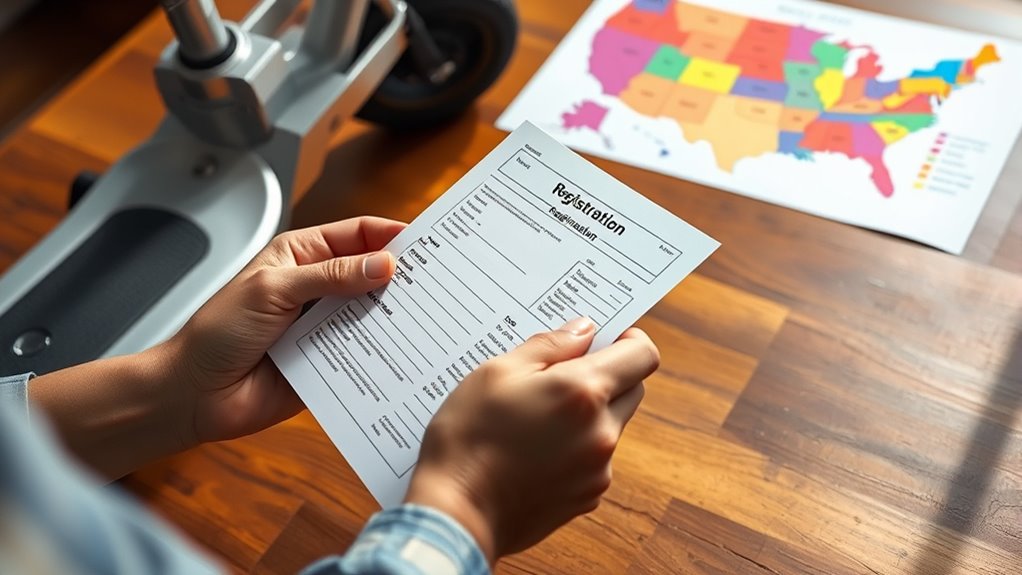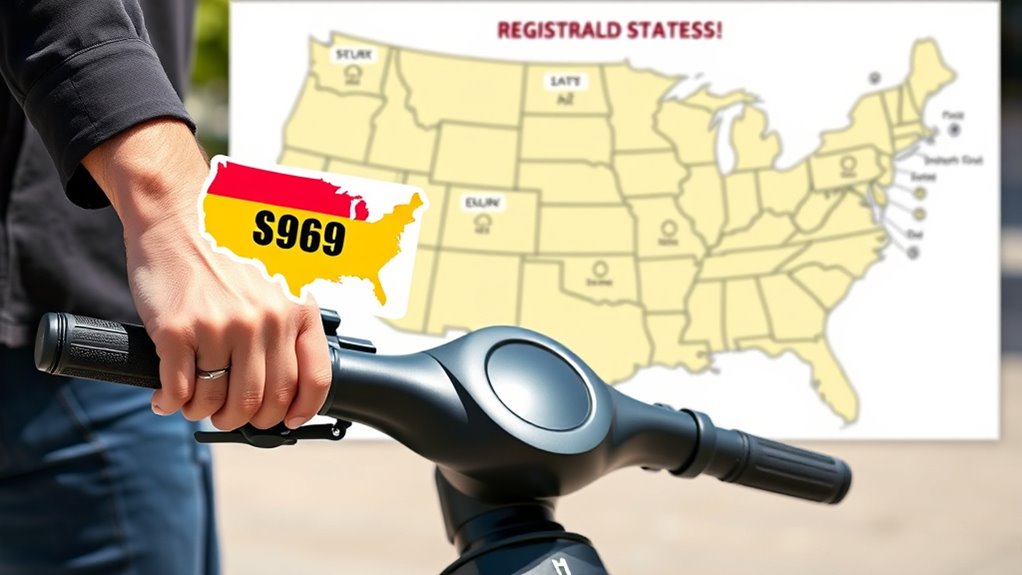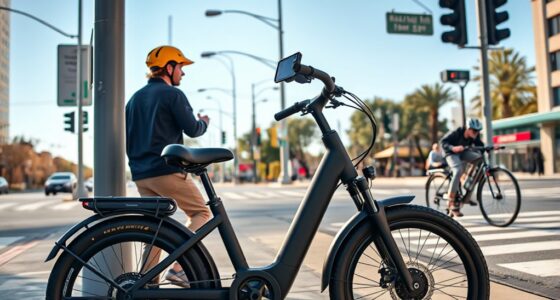To register your e-scooter in different states, first check each state’s specific laws, like helmet rules and speed limits. Gather important documents such as proof of ownership, ID, and safety certifications. Complete the registration form accurately and pay the required fee. Submit everything to the appropriate local or state agency, like the DMV, and make certain you get your license plates or stickers. Staying compliant involves keeping your registration current and following local riding rules—more details can guide you through the process.
Key Takeaways
- Research each state’s specific registration requirements, including eligibility, documentation, and fees, via official transportation or DMV resources.
- Gather necessary documents such as proof of ownership, ID, proof of residency, and safety certifications if required.
- Complete and submit registration forms either online, in person, or by mail to the appropriate state or local agency.
- Pay applicable registration fees, and properly affix any license plates or stickers provided on your e-scooter.
- Maintain registration by renewing timely, updating documentation if needed, and complying with ongoing safety and operational regulations.
Understanding State-Specific E-Scooter Laws and Regulations

Have you ever wondered why e-scooter laws vary so much from state to state? It’s mainly because each state sets its own regulations to address safety and liability concerns. Some states require helmets and limit speeds, while others focus on battery safety to prevent fire hazards. Insurance coverage also differs: a few states mandate riders have insurance, while others don’t. Knowing these differences helps you stay compliant and avoid fines. You’ll want to familiarize yourself with local laws to ensure your e-scooter meets all requirements, especially regarding safety features and insurance policies. Understanding these nuances can save you from legal trouble and ensure you ride confidently within the rules. Always check your state’s specific regulations before hitting the road. Additionally, understanding state-specific e‑scooter regulations can help you stay informed about any recent legislative updates.
Gathering Necessary Documentation for Registration

To register your e-scooter, you’ll need to gather specific documents first. Make sure you have valid identification and proof that you own the vehicle. Having these ready will help streamline the registration process in your state. Additionally, understanding registration requirements can ensure you comply with local regulations.
Required Identification Documents
Gathering the necessary identification documents is a crucial step in registering your e-scooter, as most states require proof of identity and residency. You’ll typically need a valid driver’s license or state ID to verify who you are. Some states may also ask for proof of residency, like a utility bill or lease agreement. Be prepared to show helmet safety certifications if applicable, especially for young riders, and make sure your e-scooter complies with battery regulations to meet safety standards. Having these documents ready speeds up the registration process and helps avoid delays. Always check your state’s specific requirements, as they can vary. Ensuring your documentation is complete and accurate is key to a smooth registration experience. Inspirational quotes about fatherhood can remind you of the importance of responsibility and support in such tasks.
Proof of Ownership
Bringing proof of ownership is essential for registering your e-scooter, as it confirms your legal claim to the vehicle. Typically, you’ll need a bill of sale, title, or registration certificate. Check your state’s specific requirements to guarantee you have the correct documentation. Additionally, some states may require proof of insurance, especially if insurance requirements are enforced for e-scooters. Make sure your safety equipment, like lights and reflectors, meets local standards and is functional. Here’s a quick overview:
| Document Needed | Purpose | Notes |
|---|---|---|
| Bill of Sale | Proof of purchase and transfer | Keep a copy for registration |
| Title or Registration | Legal ownership confirmation | May be required in some states |
| Insurance Proof | Meets insurance requirements | Necessary in certain jurisdictions |
| Safety Equipment Check | Ensures compliance with safety rules | Proper lights, reflectors, brakes |
Additionally, understanding the importance of vehicle registration can help ensure your e-scooter remains compliant with local laws and regulations.
Checking Eligibility Criteria for E-Scooter Registration

Before registering your e-scooter, you need to check if it meets your state’s specific requirements. Make sure you’re aware of age, license, and vehicle standards that could affect your eligibility. Knowing these criteria helps guarantee a smooth registration process. Additionally, reviewing your state’s forsale 100 listings can provide insights into the most popular and compliant models available.
State-Specific Requirements
Checking whether your e-scooter qualifies for registration in a specific state is a crucial first step. Each state has unique requirements, including e scooter insurance and battery regulations. Some states mandate proof of insurance before registration, while others don’t require it at all. Battery regulations can vary too; certain states specify maximum wattage or enforce strict safety standards to prevent overheating. You’ll need to verify if your e-scooter meets these specifications to avoid registration delays or penalties. Additionally, some states may restrict the types of e-scooters eligible for registration based on design or speed limits. Always review your state’s official guidelines to confirm your e-scooter complies with all local rules, including insurance coverage and battery safety standards, before proceeding with registration.
Age and License Rules
Understanding the age and license requirements for e-scooter registration is key to guaranteeing you meet local eligibility standards. Most states set a minimum age, often 16 or 18, to operate an e-scooter legally. You may also need a valid driver’s license or learner’s permit, depending on your state’s rules. Helmet laws vary—some states mandate helmets for all riders, while others only require them for minors. Additionally, insurance requirements might apply, especially if you plan to ride frequently or in certain areas. Check your state’s specific laws to confirm whether you need a license or permit, and always follow helmet laws to stay compliant and safe. Meeting these criteria ensures a smooth registration process and legal riding. AI in Business can also be leveraged to stay updated on changing regulations and ensure ongoing compliance.
Vehicle Eligibility Standards
Are your e-scooter meets the specific eligibility standards required for registration in your state? To qualify, your vehicle must meet criteria related to vehicle safety, like proper lighting and brakes, and fall within the legal speed limits. Check if your e-scooter’s specifications match your state’s requirements to avoid delays. Some states also have registration deadlines, so timely compliance is vital. Use the table below to quickly assess key eligibility factors:
| Requirement | Description | Compliance Check |
|---|---|---|
| Vehicle Safety | Must have working lights, brakes, and horn | Confirm before registering |
| Speed Limit | Must not exceed state-specific limits | Verify specifications |
| Vehicle Type | Should be classified as an e-scooter | Confirm registration category |
| Registration Deadline | Must register within designated timeframe | Keep track of deadlines |
Completing the Registration Application Process

Ready to complete your e-scooter registration? First, gather all necessary documents, like proof of ownership and identification. Fill out the registration application form accurately, guaranteeing all details match your documents. Be prepared to answer questions about e-scooter safety and your riding tips, as some states require proof of knowledge about safe riding practices. Double-check your information before submitting to avoid delays. If online registration is available, follow the platform’s steps carefully; otherwise, visit the designated office in person. Keep copies of your submitted forms and receipts for future reference. Completing this process correctly helps ensure your e-scooter is legally registered and ready to ride safely on public streets. Stay informed of any additional local requirements to avoid issues later. Additionally, understanding bank SWIFT/BIC codes can be helpful if you need to make or receive international payments related to your e-scooter purchase or registration process.
Paying Registration Fees and Obtaining License Plates or Stickers

How much you’ll need to pay in registration fees varies by state and sometimes by the e-scooter’s specifications, but generally, you’ll submit your payment along with your registration application. These fees help cover administrative costs and guarantee proper registration. Once paid, you’ll receive your license plate or sticker, which must be displayed clearly on your scooter. Keep in mind, some states require proof of insurance coverage for added protection. Additionally, having safety gear like helmets can sometimes be a condition for registration. Proper food handling and hygiene are essential to minimize risks associated with raw food, especially in the context of raw food diets.
Registration fees vary by state, typically paid with your application, and include license plates or stickers and insurance requirements.
- Fees can range from $5 to $50 depending on your state
- Payment methods often include online, in-person, or mail
- License plates or stickers must be affixed properly
- Maintaining valid insurance coverage may be required for renewal
Registering Your E-Scooter Through Local or State Agencies

Once you’ve paid your registration fees and received your license plate or sticker, the next step is to complete your registration through local or state agencies. This process often involves submitting proof of e scooter safety, such as a recent inspection or compliance certification, to guarantee your vehicle meets safety standards. Registering through these agencies helps authorities monitor e-scooter use, promoting safer riding environments. It also supports efforts to reduce environmental impact by encouraging responsible riding and proper maintenance. Depending on your state, you may need to visit a local DMV, transportation office, or register online via official portals. Completing this registration validates your e scooter’s legality on roads and sidewalks, giving you peace of mind and contributing to a safer, greener community. Ensuring your e-scooter meets all safety requirements can also help prevent issues related to bad lemon juice, which, while unrelated, highlights the importance of proper maintenance and safety checks.
Maintaining Registration and Complying With Ongoing Requirements

To keep your e-scooter registration valid, you must stay on top of ongoing requirements and adhere to local regulations. This includes renewing your registration when due, maintaining appropriate insurance coverage, and following parking regulations. Failing to comply could result in fines or suspension of your registration. Make sure you understand the specific insurance requirements in your state, as some areas mandate proof of insurance. Additionally, always park your e-scooter in designated areas to avoid penalties. Regularly check for updates to laws and regulations to stay compliant. Staying informed ensures you avoid legal issues and keeps your e-scooter legally on the road. Keep track of renewal deadlines, insurance policies, and parking rules to maintain your registration hassle-free. Trustworthiness of Patchology can serve as a model for ensuring your registration process is transparent and reliable.
Tips for Staying Legally Compliant While Riding in Different States

Staying legally compliant while riding your e-scooter across different states requires staying informed about each location’s specific laws and regulations. To do so, always check local rules before riding, especially if you’re part of shared scooter programs. Remember, laws vary on helmet use, speed limits, and where you can ride. Use this table to understand common differences:
| State | Helmet Law | Riding Areas | Speed Limit |
|---|---|---|---|
| California | Mandatory | Bike lanes | 15 mph |
| Texas | Optional | Streets | 20 mph |
| New York | Mandatory | Sidewalks | 15 mph |
Following these guidelines helps you enjoy eco friendly commuting responsibly while avoiding legal issues across states. Staying informed ensures safe, compliant riding wherever you go.
Being aware of environmental considerations can help you minimize your impact on natural areas during your rides.
Frequently Asked Questions
Can I Register My E-Scooter if I Bought It Out of State?
If you bought your e-scooter out of state, you might wonder if you can register it locally. State regulations vary, but generally, you’ll need to follow the registration process specific to your state. Some states require registration within a certain timeframe after purchase, regardless of where you bought it. Check your state’s DMV or transportation department for details, so you can guarantee compliance and ride legally.
Are There Age Restrictions for E-Scooter Registration?
Imagine trying to join a club without meeting its age restrictions — it’s just not allowed. Similarly, many states enforce age restrictions for e-scooter registration, often requiring riders to be at least 16 or 18. These registration requirements guarantee safety and compliance, so check your local rules before registering. Meeting age restrictions is vital; otherwise, you might face fines or denial of registration.
How Often Do I Need to Renew My E-Scooter Registration?
You’ll need to renew your e-scooter registration according to your state’s renewal deadlines, which can vary but are often annual or biennial. Be sure to stay on top of these deadlines to avoid fines. During renewal, you’ll pay registration fees, which also differ by state. Keep track of your renewal date and fees to guarantee your e-scooter remains legally registered and ready to ride.
What Happens if I Ride Without Proper Registration?
Riding without proper registration isn’t just a minor mistake; it’s like waving a red flag at a bull. You could face hefty legal penalties, including fines or even confiscation of your e-scooter. The registration process is designed to keep you safe and compliant. If you ignore it, you risk legal trouble and potential safety issues. Always guarantee your e-scooter is properly registered before hitting the streets to avoid unnecessary chaos.
Can I Transfer Registration Between Different E-Scooter Models?
You can’t transfer registration between different e-scooter models because each model has unique registration requirements and compatibility. When you switch to a new scooter, you’ll need to check if the existing registration applies or if you must complete a new registration process. Always verify model compatibility and follow local regulations to guarantee your registration transfer is valid, avoiding potential fines or legal issues.
Conclusion
Now that you know how to register your e-scooter in different states, you’re basically unstoppable! Skip a step, and you risk the wrath of the law worse than a swarm of angry wasps. Stay compliant, keep your registration updated, and ride with confidence—because nothing’s more epic than cruising legally and worry-free across state lines. Get registered, ride on, and conquer the streets like a true e-scooter legend!









